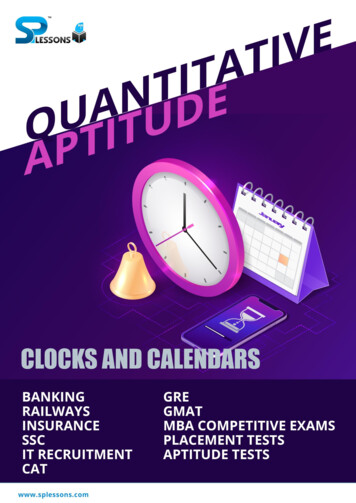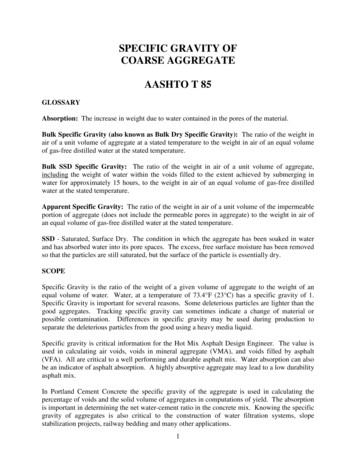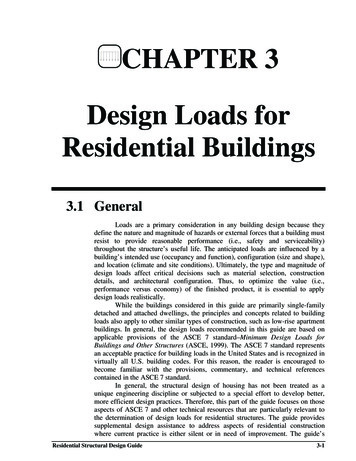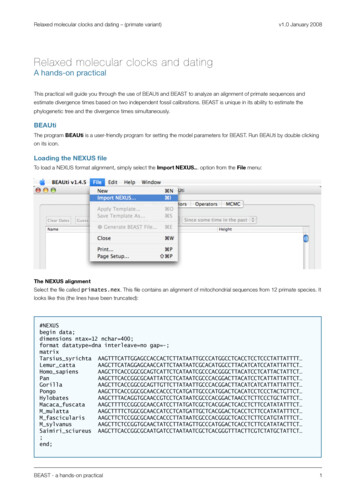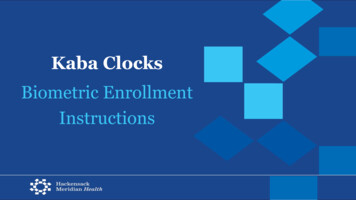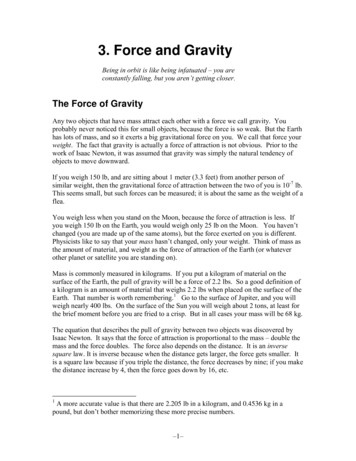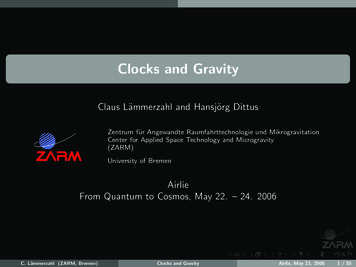
Transcription
Clocks and GravityClaus Lämmerzahl and Hansjörg DittusZentrum für Angewandte Raumfahrttechnologie und MikrogravitationCenter for Applied Space Technology and Microgravity(ZARM)University of BremenAirlieFrom Quantum to Cosmos, May 22. – 24. 2006C. Lämmerzahl (ZARM, Bremen)Clocks and GravityAirlie, May 23, 20061 / 55
Clocks and GravityWell known issuesGravitational redshiftImportant effect within Einstein’s General RelativityNeeded for clock synchronization on EarthNeeded for GPSUniversality of gravitational redshiftImportant for the structure of General RelativityPoints made hereClocks are a universal toolClocks have many important practical applicationsMost space missions may profit from clocks onboardTime and position are independent observablesTechnology and Fundamental PhysicsC. Lämmerzahl (ZARM, Bremen)Clocks and GravityAirlie, May 23, 20062 / 55
Outline1The situation of standard physicsThe statusApplicationsProblems?C. Lämmerzahl (ZARM, Bremen)Clocks and GravityAirlie, May 23, 20063 / 55
Outline1The situation of standard physicsThe statusApplicationsProblems?2Search for Quantum GravityNeed for Quantum GravityOn strategies for the search for QG effectsObservation vs. ExperimentC. Lämmerzahl (ZARM, Bremen)Clocks and GravityAirlie, May 23, 20063 / 55
Outline1The situation of standard physicsThe statusApplicationsProblems?2Search for Quantum GravityNeed for Quantum GravityOn strategies for the search for QG effectsObservation vs. Experiment3Space conditionsC. Lämmerzahl (ZARM, Bremen)Clocks and GravityAirlie, May 23, 20063 / 55
Outline1The situation of standard physicsThe statusApplicationsProblems?2Search for Quantum GravityNeed for Quantum GravityOn strategies for the search for QG effectsObservation vs. Experiment3Space conditions4Gravity anomalies (in Universe and within Solar system)AnomaliesSolar system anomaliesC. Lämmerzahl (ZARM, Bremen)Clocks and GravityAirlie, May 23, 20063 / 55
Outline1The situation of standard physicsThe statusApplicationsProblems?2Search for Quantum GravityNeed for Quantum GravityOn strategies for the search for QG effectsObservation vs. Experiment3Space conditions4Gravity anomalies (in Universe and within Solar system)AnomaliesSolar system anomalies5Clocks and orbitsC. Lämmerzahl (ZARM, Bremen)Clocks and GravityAirlie, May 23, 20063 / 55
Outline1The situation of standard physicsThe statusApplicationsProblems?2Search for Quantum GravityNeed for Quantum GravityOn strategies for the search for QG effectsObservation vs. Experiment3Space conditions4Gravity anomalies (in Universe and within Solar system)AnomaliesSolar system anomalies5Clocks and orbits6Summary and OutlookC. Lämmerzahl (ZARM, Bremen)Clocks and GravityAirlie, May 23, 20063 / 55
Outline1The situation of standard physicsThe statusApplicationsProblems?2Search for Quantum GravityNeed for Quantum GravityOn strategies for the search for QG effectsObservation vs. Experiment3Space conditions4Gravity anomalies (in Universe and within Solar system)AnomaliesSolar system anomalies5Clocks and orbits6Summary and Outlook7Final remark: Technology and Fundamental PhyiscsC. Lämmerzahl (ZARM, Bremen)Clocks and GravityAirlie, May 23, 20063 / 55
The situation of standard physicsOutline1The situation of standard physicsThe statusApplicationsProblems?2Search for Quantum GravityNeed for Quantum GravityOn strategies for the search for QG effectsObservation vs. Experiment3Space conditions4Gravity anomalies (in Universe and within Solar system)AnomaliesSolar system anomalies5Clocks and orbits6Summary and Outlook7Final remark: Technology and Fundamental PhyiscsC. Lämmerzahl (ZARM, Bremen)Clocks and GravityAirlie, May 23, 20064 / 55
The situation of standard physicsThe statusOutline1The situation of standard physicsThe statusApplicationsProblems?2Search for Quantum GravityNeed for Quantum GravityOn strategies for the search for QG effectsObservation vs. Experiment3Space conditions4Gravity anomalies (in Universe and within Solar system)AnomaliesSolar system anomalies5Clocks and orbits6Summary and Outlook7Final remark: Technology and Fundamental PhyiscsC. Lämmerzahl (ZARM, Bremen)Clocks and GravityAirlie, May 23, 20065 / 55
The situation of standard physicsThe statusStructure of standard physicsEinstein Equivalence PrincipleUniversalityof Free FallUniversality ofGravitat. RedshiftLorentzInvarianceMatter determinesgravityEquations of motion for matterMaxwell–equationDirac–equationGeneral RelativityGravity MetricEinstein–equationsGravity determinesdynamicsC. Lämmerzahl (ZARM, Bremen)Clocks and GravityAirlie, May 23, 20066 / 55
The situation of standard physicsThe statusThe present situationAll aspects of Lorentz invariance are experimentally well tested and confirmedFoundationsPostulatesc constPrinciple of RelativityC. Lämmerzahl (ZARM, Bremen)Clocks and GravityAirlie, May 23, 20067 / 55
The situation of standard physicsThe statusThe present situationAll aspects of Lorentz invariance are experimentally well tested and confirmedFoundationsPostulatesc constTests Clock testsIndependence of c fromvelocity of the sourceUniversality of cIsotropy of cPrinciple of RelativityIndependence of c fromvelocity of the laboratoryTime dilationIsotropy of physics(Hughes–Dreverexperiments)Independence of physics fromthe velocity of the laboratoryC. Lämmerzahl (ZARM, Bremen)Clocks and GravityAirlie, May 23, 20067 / 55
The situation of standard physicsThe statusThe present situationMany aspects of the Universality of Free Fall are experimentally well tested andconfirmedPostulateIn a gravitational field allstructureless test particles fall inthe same wayC. Lämmerzahl (ZARM, Bremen)Clocks and GravityAirlie, May 23, 20068 / 55
The situation of standard physicsThe statusThe present situationMany aspects of the Universality of Free Fall are experimentally well tested andconfirmedPostulateIn a gravitational field allstructureless test particles fall inthe same wayTestsUFF forNeutral bulk matterCharged particlesParticles with spinNo test so far forAnti particlesC. Lämmerzahl (ZARM, Bremen)Clocks and GravityAirlie, May 23, 20068 / 55
The situation of standard physicsThe statusThe present situationMany aspects of the Universality of the Gravitational Redshift are experimentallywell tested and confirmedPostulateIn a gravitational field all clocksbehave in the same waygC. Lämmerzahl (ZARM, Bremen)Clocks and GravityAirlie, May 23, 20069 / 55
The situation of standard physicsThe statusThe present situationMany aspects of the Universality of the Gravitational Redshift are experimentallywell tested and confirmedPostulateIn a gravitational field all clocksbehave in the same wayTests ( Clock tests)UGR forAtomic clocks: electronicAtomic clocks: hyperfineMolecular clocks: vibrationalMolecular clocks: rotationalgResonatorsNuclear transitions(Mössbauer effect)No test so far forAnti clocksC. Lämmerzahl (ZARM, Bremen)Clocks and GravityAirlie, May 23, 20069 / 55
The situation of standard physicsThe statusUniversal toolClocks are a universal tool for testing space–time propertiesGR: Physics of position and time (trajectories of particles and light rays)SR: Based solely on clock camparison experimentsUGR: clock comparison experimentClock with hypotheticanomal dependence onposition, orientation, and velocityClock 1ν1Clock with different hypotheticanomal dependence onposition, orientation, and velocity Clock 2ν2comparisonν2 ν1C. Lämmerzahl (ZARM, Bremen)Clocks and GravityAirlie, May 23, 200610 / 55
The situation of standard physicsThe statusClocksClocks of different nature exhibit a different dependence on fundamental constantsScaling of transition energies (in units of Rydberg energy)Hyperfine energies g(me /mp )α2 f (α) Vibrational energies in molecules me /mpRotational energies in molecules me /mpFine-structure energies α2Electronic energies (incl. relativistic effects) f (α)Cavity frequency 1/αWeak interaction splitting/Zeeman frequency GFC. Lämmerzahl (ZARM, Bremen)Clocks and GravityAirlie, May 23, 200611 / 55
The situation of standard physicsThe statusTest of time–dilation: Transport of clocksDevelopment of good clocks clocks on aircraft: Experiment byHafele and Keating 1968 to test time dilationWe shall do the same today: Put the best clocks on spacecraft and test clockeffects!C. Lämmerzahl (ZARM, Bremen)Clocks and GravityAirlie, May 23, 200612 / 55
The situation of standard physicsThe statusThe present situationAll predictions of Einstein’s General Relativity are experimentally well tested andconfirmedFoundationsThe Einstein EquivalencePrincipleUniversality of Free FallUniversality of GravitationalRedshiftLocal Lorentz InvarianceC. Lämmerzahl (ZARM, Bremen)Clocks and GravityAirlie, May 23, 200613 / 55
The situation of standard physicsThe statusThe present situationAll predictions of Einstein’s General Relativity are experimentally well tested andconfirmedFoundationsThe Einstein EquivalencePrincipleUniversality of Free FallPredictions from GRSolar system effectsUniversality of GravitationalRedshiftLocal Lorentz InvariancePerihelion shiftGravitational redshiftDeflection of lightGravitational time delayLense–Thirring effectSchiff effectStrong gravitational fieldsBinary systemsBlack holesGravitational wavesCosmologyC. Lämmerzahl (ZARM, Bremen)Clocks and GravityAirlie, May 23, 200613 / 55
The situation of standard physicsApplicationsOutline1The situation of standard physicsThe statusApplicationsProblems?2Search for Quantum GravityNeed for Quantum GravityOn strategies for the search for QG effectsObservation vs. Experiment3Space conditions4Gravity anomalies (in Universe and within Solar system)AnomaliesSolar system anomalies5Clocks and orbits6Summary and Outlook7Final remark: Technology and Fundamental PhyiscsC. Lämmerzahl (ZARM, Bremen)Clocks and GravityAirlie, May 23, 200614 / 55
The situation of standard physicsApplicationsMetrologyA10SR ensuresuniqueness oftimekeeping inmoving frames 124 · 10 8mSR: Constancy ofspeed of lightmol8 · 10 8cd10 4sGR ensuresuniqueness oftimekeeping ingravitational fields3 · 10 15GR ensuresuniqueness ofdefinition of masskgunknown ageingof prototypeK3 · 10 7SR & GR Physics of space and time fundamental metrologyC. Lämmerzahl (ZARM, Bremen)Clocks and GravityAirlie, May 23, 200615 / 55
The situation of standard physicsApplicationsMetrologyC. Lämmerzahl (ZARM, Bremen)Clocks and GravityAirlie, May 23, 200616 / 55
The situation of standard physicsApplicationsTAIC. Lämmerzahl (ZARM, Bremen)Clocks and GravityAirlie, May 23, 200617 / 55
The situation of standard physicsApplicationsTime scalesC. Lämmerzahl (ZARM, Bremen)Clocks and GravityAirlie, May 23, 200618 / 55
The situation of standard physicsApplicationsPractical application: Clocks and climate researchC. Lämmerzahl (ZARM, Bremen)Clocks and GravityAirlie, May 23, 200619 / 55
The situation of standard physicsApplicationsPractical application: Clocks and climate researchC. Lämmerzahl (ZARM, Bremen)Clocks and GravityAirlie, May 23, 200620 / 55
The situation of standard physicsApplicationsPractical application: Clocks and Earth dynamicsClocks are of help tomeasure:warming of oceans.motion of Earth’scrust, .C. Lämmerzahl (ZARM, Bremen)Clocks and GravityAirlie, May 23, 200621 / 55
The situation of standard physicsApplicationsPractical application: Clocks and positionsC. Lämmerzahl (ZARM, Bremen)Clocks and GravityAirlie, May 23, 200622 / 55
The situation of standard physicsProblems?Outline1The situation of standard physicsThe statusApplicationsProblems?2Search for Quantum GravityNeed for Quantum GravityOn strategies for the search for QG effectsObservation vs. Experiment3Space conditions4Gravity anomalies (in Universe and within Solar system)AnomaliesSolar system anomalies5Clocks and orbits6Summary and Outlook7Final remark: Technology and Fundamental PhyiscsC. Lämmerzahl (ZARM, Bremen)Clocks and GravityAirlie, May 23, 200623 / 55
The situation of standard physicsProblems?Problems?Issues to be reslovedNeed for Quantum GravityGravity ”anomalies”C. Lämmerzahl (ZARM, Bremen)Clocks and GravityAirlie, May 23, 200624 / 55
Search for Quantum GravityOutline1The situation of standard physicsThe statusApplicationsProblems?2Search for Quantum GravityNeed for Quantum GravityOn strategies for the search for QG effectsObservation vs. Experiment3Space conditions4Gravity anomalies (in Universe and within Solar system)AnomaliesSolar system anomalies5Clocks and orbits6Summary and Outlook7Final remark: Technology and Fundamental PhyiscsC. Lämmerzahl (ZARM, Bremen)Clocks and GravityAirlie, May 23, 200625 / 55
Search for Quantum GravityNeed for Quantum GravityOutline1The situation of standard physicsThe statusApplicationsProblems?2Search for Quantum GravityNeed for Quantum GravityOn strategies for the search for QG effectsObservation vs. Experiment3Space conditions4Gravity anomalies (in Universe and within Solar system)AnomaliesSolar system anomalies5Clocks and orbits6Summary and Outlook7Final remark: Technology and Fundamental PhyiscsC. Lämmerzahl (ZARM, Bremen)Clocks and GravityAirlie, May 23, 200626 / 55
Search for Quantum GravityNeed for Quantum GravityThe need for Quantum GravityFrame theoriesQuantum theorySpecial RelativityGeneral RelativityStatistical mechanicsProblemIncompatibility of quantumtheory and General RelativityInteractionsElectrodynamicsGravityWeak interactionStrong interactionWishUnification of all interactionsAvoiding SingularitiesResolving the problem of timeNeed of modifications of standard physics search for modificationsC. Lämmerzahl (ZARM, Bremen)Clocks and GravityAirlie, May 23, 200627 / 55
Search for Quantum GravityNeed for Quantum GravityPossible effectsPossible geometry relevant effectsOther possible effectsAnisotropic speed of lightDecoherenceAnisotropy in quantum fieldsViolation of UFF, UGRModified interferenceNon–localitiesBirefringenceAnomalous spin–couplingStructure of parametersUsually: parameters are asumedto be constantAnomalous coupling of chargeAnomalous dispersionIn unification scenarios:parameters depend on time andposition, through scalar fields(dilaton, quintessence, varyinge) scalar–tensor theoriesNewton / Coulomb potentialNonlinearitiesCharge non–conservationActive – passive mass andchargeMany of them typically clock testsClocks are an important device in the search for QGC. Lämmerzahl (ZARM, Bremen)Clocks and GravityAirlie, May 23, 200628 / 55
Search for Quantum GravityOn strategies for the search for QG effectsOutline1The situation of standard physicsThe statusApplicationsProblems?2Search for Quantum GravityNeed for Quantum GravityOn strategies for the search for QG effectsObservation vs. Experiment3Space conditions4Gravity anomalies (in Universe and within Solar system)AnomaliesSolar system anomalies5Clocks and orbits6Summary and Outlook7Final remark: Technology and Fundamental PhyiscsC. Lämmerzahl (ZARM, Bremen)Clocks and GravityAirlie, May 23, 200629 / 55
Search for Quantum GravityOn strategies for the search for QG effectsStrategy: Exploration of new regimesStandard physics experimentally well proven for standard energies, velocities,distances, .Search for new effects need to go to non–standard situations:C. Lämmerzahl (ZARM, Bremen)Clocks and GravityAirlie, May 23, 200630 / 55
Search for Quantum GravityOn strategies for the search for QG effectsStrategy: Exploration of new regimesStandard physics experimentally well proven for standard energies, velocities,distances, .Search for new effects need to go to non–standard situations:Non–standard situationsExtreme high energies. Deviations from the standard dispersion relationExtreme low energies. Space–time fluctuations, decoherence may affect quantumsystems at temperatures lower than 500 fK achieved in BECsC. Lämmerzahl (ZARM, Bremen)Clocks and GravityAirlie, May 23, 200630 / 55
Search for Quantum GravityOn strategies for the search for QG effectsStrategy: Exploration of new regimesStandard physics experimentally well proven for standard energies, velocities,distances, .Search for new effects need to go to non–standard situations:Non–standard situationsExtreme high energies. Deviations from the standard dispersion relationExtreme low energies. Space–time fluctuations, decoherence may affect quantumsystems at temperatures lower than 500 fK achieved in BECsExtreme large distances.Dark energy, dark matter, Pioneer anomalyUltra–low frequency gravitational waves (early universe)Extreme small distances. Higher dimensional theories: violation of Newton’s lawat small (sub–mm) distancesC. Lämmerzahl (ZARM, Bremen)Clocks and GravityAirlie, May 23, 200630 / 55
Search for Quantum GravityOn strategies for the search for QG effectsStrategy: Exploration of new regimesStandard physics experimentally well proven for standard energies, velocities,distances, .Search for new effects need to go to non–standard situations:Non–standard situationsExtreme high energies. Deviations from the standard dispersion relationExtreme low energies. Space–time fluctuations, decoherence may affect quantumsystems at temperatures lower than 500 fK achieved in BECsExtreme large distances.Dark energy, dark matter, Pioneer anomalyUltra–low frequency gravitational waves (early universe)Extreme small distances. Higher dimensional theories: violation of Newton’s lawat small (sub–mm) distancesExtreme long timescales.Search for space–time fluctuations in terms of 1/f –noiseTime dependence of constantsExtreme short timescales. Short time scales large energiesC. Lämmerzahl (ZARM, Bremen)Clocks and GravityAirlie, May 23, 200630 / 55
Search for Quantum GravityObservation vs. ExperimentOutline1The situation of standard physicsThe statusApplicationsProblems?2Search for Quantum GravityNeed for Quantum GravityOn strategies for the search for QG effectsObservation vs. Experiment3Space conditions4Gravity anomalies (in Universe and within Solar system)AnomaliesSolar system anomalies5Clocks and orbits6Summary and Outlook7Final remark: Technology and Fundamental PhyiscsC. Lämmerzahl (ZARM, Bremen)Clocks and GravityAirlie, May 23, 200631 / 55
Search for Quantum GravityObservation vs. ExperimentObservations vs. ExperimentComparison: high energy cosmic ray observation low energy laboratory exp.C. Lämmerzahl (ZARM, Bremen)Clocks and GravityAirlie, May 23, 200632 / 55
Search for Quantum GravityObservation vs. ExperimentObservations vs. ExperimentComparison: high energy cosmic ray observation low energy laboratory exp.Astrophysical observations Availability of ultra high energies of more than 1021 eV– No systematic repeatability– No unique interpretationC. Lämmerzahl (ZARM, Bremen)Clocks and GravityAirlie, May 23, 200632 / 55
Search for Quantum GravityObservation vs. ExperimentObservations vs. ExperimentComparison: high energy cosmic ray observation low energy laboratory exp.Astrophysical observations Availability of ultra high energies of more than 1021 eV– No systematic repeatability– No unique interpretationLaboratory search (including space)– Only small energies are available Repeatability of the experiment, systematic variation of initial and boundaryconditions, used for:Identification of causeImprovement of precision of result Ultra–low temperatures, ultrastable devices like optical resonators can beobtained in the laboratory / in space onlyC. Lämmerzahl (ZARM, Bremen)Clocks and GravityAirlie, May 23, 200632 / 55
Search for Quantum GravityObservation vs. ExperimentObservations vs. ExperimentComparison: high energy cosmic ray observation low energy laboratory exp.Astrophysical observations Availability of ultra high energies of more than 1021 eV– No systematic repeatability– No unique interpretationLaboratory search (including space)– Only small energies are available Repeatability of the experiment, systematic variation of initial and boundaryconditions, used for:Identification of causeImprovement of precision of result Ultra–low temperatures, ultrastable devices like optical resonators can beobtained in the laboratory / in space onlyDue to stability and repeatability of experiments, laboratory searches for quantumgravity effects may be as promising as astrophysical observationsC. Lämmerzahl (ZARM, Bremen)Clocks and GravityAirlie, May 23, 200632 / 55
Space conditionsOutline1The situation of standard physicsThe statusApplicationsProblems?2Search for Quantum GravityNeed for Quantum GravityOn strategies for the search for QG effectsObservation vs. Experiment3Space conditions4Gravity anomalies (in Universe and within Solar system)AnomaliesSolar system anomalies5Clocks and orbits6Summary and Outlook7Final remark: Technology and Fundamental PhyiscsC. Lämmerzahl (ZARM, Bremen)Clocks and GravityAirlie, May 23, 200633 / 55
Space conditionsSpace conditionsParticular space conditions and corresponding testsSpace conditionsTestsFree fall – no gravitational forceC. Lämmerzahl (ZARM, Bremen)Clocks and GravityAirlie, May 23, 200634 / 55
Space conditionsSpace conditionsParticular space conditions and corresponding testsSpace conditionsFree fall – no gravitational forceTestsTest of Universality of Free FallLong time for accumulatingsmall forcesC. Lämmerzahl (ZARM, Bremen)Clocks and GravityAirlie, May 23, 200634 / 55
Space conditionsSpace conditionsParticular space conditions and corresponding testsSpace conditionsFree fall – no gravitational forceTestsTest of Universality of Free FallLarge differences in thegravitational potentialLong time for accumulatingsmall forcesC. Lämmerzahl (ZARM, Bremen)Clocks and GravityAirlie, May 23, 200634 / 55
Space conditionsSpace conditionsParticular space conditions and corresponding testsSpace conditionsFree fall – no gravitational forceTestsTest of Universality of Free FallTest of Universality ofGravitational RedshiftMeasurement of absolutegravitational redshiftLarge differences in thegravitational potentialLong time for accumulatingsmall forcesC. Lämmerzahl (ZARM, Bremen)Clocks and GravityAirlie, May 23, 200634 / 55
Space conditionsSpace conditionsParticular space conditions and corresponding testsSpace conditionsFree fall – no gravitational forceTestsTest of Universality of Free FallTest of Universality ofGravitational RedshiftMeasurement of absolutegravitational redshiftLarge differences in thegravitational potentialHuge distancesLong time for accumulatingsmall forcesC. Lämmerzahl (ZARM, Bremen)Clocks and GravityAirlie, May 23, 200634 / 55
Space conditionsSpace conditionsParticular space conditions and corresponding testsSpace conditionsFree fall – no gravitational forceTestsTest of Universality of Free FallTest of Universality ofGravitational RedshiftMeasurement of absolutegravitational redshiftLarge differences in thegravitational potentialHuge distancesLong time for accumulatingsmall forcesNewton at large distanceslow frequency gravitationalwavesC. Lämmerzahl (ZARM, Bremen)Clocks and GravityAirlie, May 23, 200634 / 55
Space conditionsSpace conditionsParticular space conditions and corresponding testsSpace conditionsFree fall – no gravitational forceTestsTest of Universality of Free FallTest of Universality ofGravitational RedshiftMeasurement of absolutegravitational redshiftLarge differences in thegravitational potentialHuge distancesLarge velocitiesLong time for accumulatingsmall forcesNewton at large distanceslow frequency gravitationalwavesC. Lämmerzahl (ZARM, Bremen)Clocks and GravityAirlie, May 23, 200634 / 55
Space conditionsSpace conditionsParticular space conditions and corresponding testsSpace conditionsFree fall – no gravitational forceTestsTest of Universality of Free FallTest of Universality ofGravitational RedshiftMeasurement of absolutegravitational redshiftTest of Lorentz invarianceLarge differences in thegravitational potentialHuge distancesLarge velocitiesLong time for accumulatingsmall forcesNewton at large distanceslow frequency gravitationalwavesC. Lämmerzahl (ZARM, Bremen)Clocks and GravityAirlie, May 23, 200634 / 55
Space conditionsSpace conditionsParticular space conditions and corresponding testsSpace conditionsFree fall – no gravitational forceTestsTest of Universality of Free FallTest of Universality ofGravitational RedshiftMeasurement of absolutegravitational redshiftTest of Lorentz invarianceLarge differences in thegravitational potentialHuge distancesLarge velocitiesLow noiseWell–defined clocksLong time for accumulatingsmall forcesNewton at large distanceslow frequency gravitationalwavesC. Lämmerzahl (ZARM, Bremen)Clocks and GravityAirlie, May 23, 200634 / 55
Space conditionsSpace conditionsParticular space conditions and corresponding testsTest of UFFMICROSCOPESTEP, GG, HYPERFree fall – no gravit. forceLong accumul. small forcesGP-BHYPERLarge diff. in grav. pot.Test of UGRHuge distancesabsolute gravitat. redshiftACES, GP-AOPTISLarge velocitiesRelativistic gravityLLR, CassiniLATOR, ASTRODLow noiseNewton at large distancesDSGEWell–defined timelow frequency gravit. wavesLISAASTRODTest of LIACES, OPTIS, PARCS,SUMO, RACEC. Lämmerzahl (ZARM, Bremen)Clocks and GravityACES, OPTIS, PARCS,SUMO, SPACETIME, RACAirlie, May 23, 200635 / 55
Space conditionsExample: OPTISOPTIS OPtical Tests of the Isotropy of SpaceOPTIS Mission for improved tests of Special and General RelativityObjectives: Michelson–Morley, Kennedy–Thorndike, time dilation, UGR, absoluteredshift, perihelion shift, Lense–Thirring, Yukawa ( poster)C. Lämmerzahl (ZARM, Bremen)Clocks and GravityAirlie, May 23, 200636 / 55
Gravity anomalies (in Universe and within Solar system)Outline1The situation of standard physicsThe statusApplicationsProblems?2Search for Quantum GravityNeed for Quantum GravityOn strategies for the search for QG effectsObservation vs. Experiment3Space conditions4Gravity anomalies (in Universe and within Solar system)AnomaliesSolar system anomalies5Clocks and orbits6Summary and Outlook7Final remark: Technology and Fundamental PhyiscsC. Lämmerzahl (ZARM, Bremen)Clocks and GravityAirlie, May 23, 200637 / 55
Gravity anomalies (in Universe and within Solar system)AnomaliesOutline1The situation of standard physicsThe statusApplicationsProblems?2Search for Quantum GravityNeed for Quantum GravityOn strategies for the search for QG effectsObservation vs. Experiment3Space conditions4Gravity anomalies (in Universe and within Solar system)AnomaliesSolar system anomalies5Clocks and orbits6Summary and Outlook7Final remark: Technology and Fundamental PhyiscsC. Lämmerzahl (ZARM, Bremen)Clocks and GravityAirlie, May 23, 200638 / 55
Gravity anomalies (in Universe and within Solar system)AnomaliesBut: Dark clouds over General Relativity?Unexplained observationsC. Lämmerzahl (ZARM, Bremen)Clocks and GravityAirlie, May 23, 200639 / 55
Gravity anomalies (in Universe and within Solar system)AnomaliesBut: Dark clouds over General Relativity?Unexplained observationsDark Matter (Zwicky 1933)Needed to describe galactic rotation curves, lensing, structure formationC. Lämmerzahl (ZARM, Bremen)Clocks and GravityAirlie, May 23, 200639 / 55
Gravity anomalies (in Universe and within Solar system)AnomaliesBut: Dark clouds over General Relativity?Unexplained observationsDark Matter (Zwicky 1933)Needed to describe galactic rotation curves, lensing, structure formationDark Energy (Turner 1999)Needed to describe the accelerated expansion of our universeC. Lämmerzahl (ZARM, Bremen)Clocks and GravityAirlie, May 23, 200639 / 55
Gravity anomalies (in Universe and within Solar system)AnomaliesBut: Dark clouds over General Relativity?Unexplained observationsDark Matter (Zwicky 1933)Needed to describe galactic rotation curves, lensing, structure formationDark Energy (Turner 1999)Needed to describe the accelerated expansion of our universePioneer Anomaly (Anderson et al 1998, 2002)Non–Newtonian acceleration of Pioneer spacecraft toward the SunC. Lämmerzahl (ZARM, Bremen)Clocks and GravityAirlie, May 23, 200639 / 55
Gravity anomalies (in Universe and within Solar system)AnomaliesBut: Dark clouds over General Relativity?Unexplained observationsDark Matter (Zwicky 1933)Needed to describe galactic rotation curves, lensing, structure formationDark Energy (Turner 1999)Needed to describe the accelerated expansion of our universePioneer Anomaly (Anderson et al 1998, 2002)Non–Newtonian acceleration of Pioneer spacecraft toward the SunFlyby anomaly (ESA and NASA communications)Satellite velocities are too large by a few mm/s after fly–bysC. Lämmerzahl (ZARM, Bremen)Clocks and GravityAirlie, May 23, 200639 / 55
Gravity anomalies (in Universe and within Solar system)AnomaliesBut: Dark clouds over General Relativity?Unexplained observationsDark Matter (Zwicky 1933)Needed to describe galactic rotation curves, lensing, structure formationDark Energy (Turner 1999)Needed to describe the accelerated expansion of our universePioneer Anomaly (Anderson et al 1998, 2002)Non–Newtonian acceleration of Pioneer spacecraft toward the SunFlyby anomaly (ESA and NASA communications)Satellite velocities are too large by a few mm/s after fly–bysIncrease of Astronomical Unit (Krasinski & Brumberg 2005, Pitjeva 2005)Distance Earth–Sun increases by 10 m/cyC. Lämmerzahl (ZARM, Bremen)Clocks and GravityAirlie, May 23, 200639 / 55
Gravity anomalies (in Universe and within Solar system)AnomaliesBut: Dark clouds over General Relativity?Unexplained observationsDark Matter (Zwicky 1933)Needed to describe galactic rotation curves, lensing, structure formationDark Energy (Turner 1999)Needed to describe the accelerated expansion of our universePioneer Anomaly (Anderson et al 1998, 2002)Non–Newtonian acceleration of Pioneer spacecraft toward the SunFlyby anomaly (ESA and NASA communications)Satellite velocities are too large by a few mm/s after fly–bysIncrease of Astronomical Unit (Krasinski & Brumberg 20
From Quantum to Cosmos, May 22. – 24. 2006 C. L ammerzahl (ZARM, Bremen) Clocks and Gravity Airlie, May 23, 2006 1 / 55. Clocks and Gravity Well known issues . All predictions of Einstein’s General Relativity are experimentally well tested and confirmed Foundations The
